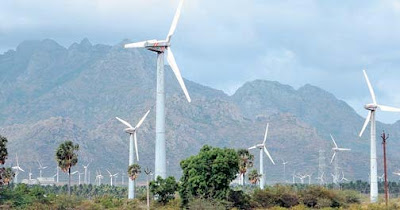CBSE Class 10 - Science - Paragraph Based Questions (New Pattern - 2019-2020)
In 2019-20 curriculum, CBSE has introduced new patterns of questions that will be asked in secondary examination. One such new pattern is paragraph based questions. CBSE has published a sample question paper providing examples in it. Here are few sample questions given based on the pattern.
Question 1: Answer question numbers 1(a) - 1(d) on the basis of your understanding of the following paragraph and the related studied concepts.
Renewable energy sources such as wind energy are vital for the Indian economy, not only from the point of view of supply, but also from the perspective of environmental and social benefits. India is the world’s fifth largest wind-power producer and the largest windmill facilities in India are installed in Tamil Nadu. Muppandal is a small village of Tamil Nadu and one of the most important sites of wind-farm in the state. It uses wind from the Arabian Sea to produce renewable energy. The suitability of Muppandal as a site for wind farms stems from its geographical location as it has access to the seasonal monsoon winds.
The electrical generators used on wind turbines in sites like Muppandal, produce an output AC of 240 V and a frequency of 50 Hz even when the wind speed is fluctuating. A transformer may be required to increase or decrease the voltage so it is compatible with the end usage, distribution or transmission voltage, depending on the type of interconnection.
1(a): State the principle behind electric generator. (1 mark)
1(b): The output frequency of wind turbine is 50 Hz. What is meant by this statement? (1 mark)
1(c): Why do you think Muppandal is at an advantageous position for this project? (1 mark)
1(d): Based on the data represented in the graph below, which of the two cities A or B would be an ideal location for establishing a wind-farm and why? (1 mark)
Answers:
1(a): The principle behind electric generator is Electromagnetic Induction- the phenomenon of producing current in a coil by changing the magnetic field associated with it.
1(b): The polarity of the output alternating current changes every 1/100 seconds. OR In 1 second the output (AC) completes 50 cycles.
1(c): The suitability of Muppandal as a site for wind farms stems from its geographical location as it has access to the seasonal monsoon winds.
1(d): City A
It is more suitable for a wind-farm as there is consistently high wind-speed in that city throughout the year.
Question 2: Read the paragraph below and answer the following MCQs:
Cell body is the main art of a nerve cell. A large nucleus is present in the middle of the cell body. It also contains cytoplasm. Dendron are hair-like parts arises from the cell body. Various branches come out of the Dendron and these are called dendrites. Each neuron has a long, thick and cylindrical part, which is called axon. The nerve endings attached to the lateral braches of the axon, known as synapse. Dendrites receive impulses and axon takes away from the cell body.
2(a): What is the main part of nerve cell?
(i) Nucleus
(ii) Cell body
(iii) Cytoplasm
(iv) Dendrites
2(b): Name the hair-like part arising from the cell body.
(i) Dendron
(ii) Axon
(iii) Synapse
(iv) None of these
2(c): What is the shape of axon?
(i) Rectangular
(ii) Cylindrical
(iii) Circular
(iv) Spherical
2(d): What is attached to the lateral branch of axon?
(i) Nucleus
(ii) Nerve Endings
(iii) Synapse
(iv) Dendrites
Answers:
2(a) - Cell body
2(b) - Dendron
2(c) - Cylindrical
2(d) - Nerve Endings
Question 3: Question numbers 3(a) - 3(d) are based on the two tables given below. Study these tables related to blood sugar levels and answer the questions that follow.
Table A (Blood glucose chart)
| Mean Blood Glucose Level (mg/dL) | |
|---|---|
| Doctor’s advice needed | 380 |
| 350 | |
| 315 | |
| 280 | |
| 250 | |
| 215 | |
| Good | 180 |
| 150 | |
| Excellent | 115 |
| 80 | |
| 50 |
Table B (Blood Report of Patient X and Y)
| Time to Check | Blood Glucose ranges (mg/dL) | |
|---|---|---|
| Patient X | Patient Y | |
| Before breakfast (Fasting) | < 100 | 70 – 130 |
| Before lunch, supper and snack | < 110 | 70 – 130 |
| Two hours after meals | < 140 | < 180 |
| Bedtime | < 120 | 90-15 |
3(a): Refer to Table B showing the blood report of the levels of glucose of patients X and Y. Infer the disease which can be diagnosed from the given data.
3(b): Identify the hormone whose level in the blood is responsible for the above disease.
3(c): Which one of the following diets would you recommended to the affected patient?
i) High sugar and low fat diet.
ii) Low sugar and high protein diet.
iii) High Fat and low fiber diet.
iv) Low sugar and high fiber diet.
3(d): Refer to the Table A and suggest the value of the mean blood glucose level beyond which doctor’s advice is necessary:
i) 180 mg/dL
ii) 115 mg/dL
iii) 50 mg/dL
iv) 80 mg/dL
Answers:
3(a): Diabetes
3(b): Insulin
3(c): iv) low sugar high fibre diet
3(d): i) 180mg/dL



No comments:
Post a Comment
We love to hear your thoughts about this post!
Note: only a member of this blog may post a comment.